|
EQUINE CLICKER TRAINING..... using precision and positive reinforcement to teach horses and people |
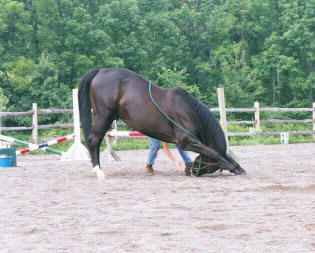
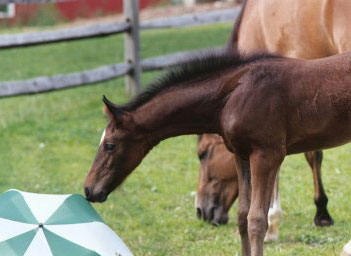
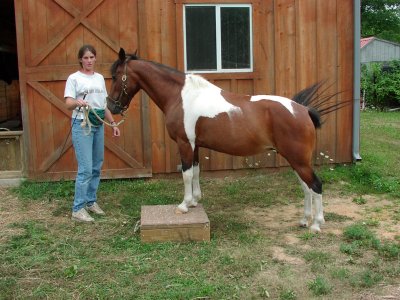
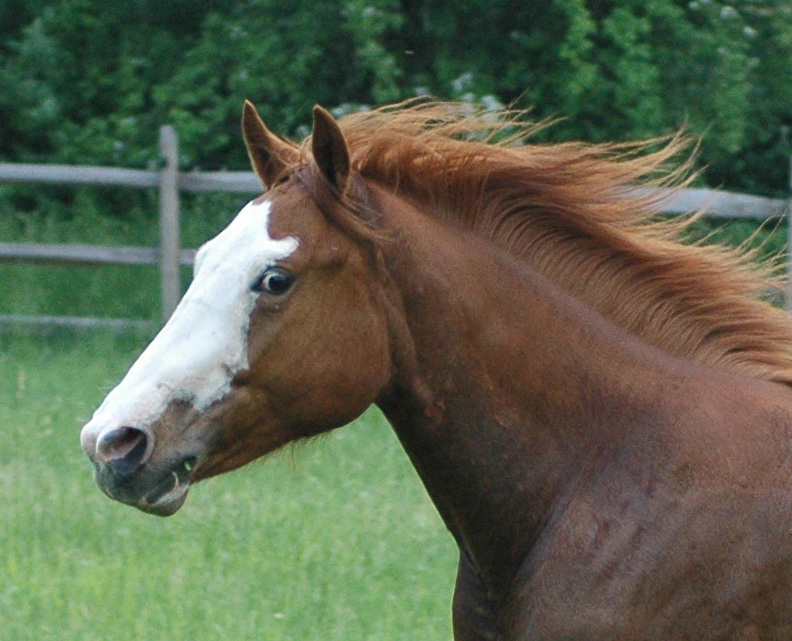
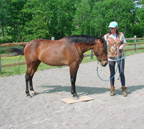
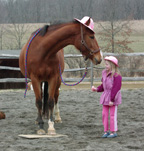
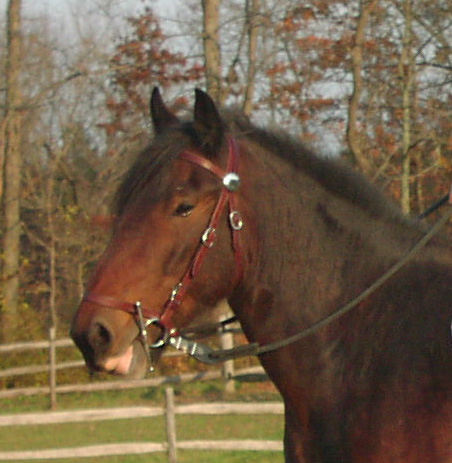
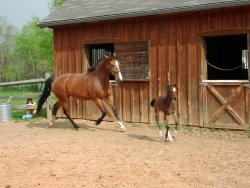 |
|
Connecting Single Rein Riding (SRR) to traditional cues: moving the shoulders This article was originally posted on the clickryder and click_that_teaches yahoo lists in response to a member whose horse had started to interpret the pickup of the rein as a request to move laterally. It explains how to develop turns so that the horse understands how to move its shoulders in either direction using SRR and then how to connect that to the traditional cues of an opening rein or riding on two reins. Traditionally horses are taught to turn by bringing their noses to the side in the direction we want them to go. Most horses follow their noses so this will work in a lot of cases. However, with some horses, if you bring the nose to the side, the shoulders do not follow because the horse either drifts out the outside shoulder or ďrubbernecksí and keeps going straight. Traditional trainers do one of two things to solve this problem. They either keep bringing the nose around until the horse makes the turn or they shorten the outside rein to prevent the horse from popping his outside shoulder. This makes steering the horse more like a bicycle. In addition, you can add outside leg to encourage the horse move away from it. This would be using an opening rein. As the horse became more advanced, there would be less of an opening aspect and it would become more of a direct rein. This is an important point because an opening rein can encourage a horse to fall on his forehand and lean on his inside shoulder.
There is nothing wrong with this approach. I do think that if people asked with less rein to start with, that the horse would not overbend his neck and would bring the shoulders around if they just waited. But most riding is not trained that way. There is an emphasis on getting a response, not waiting for one. And I donít think that using the outside rein to help clarify is bad for the horse. But I do think that there are two obvious shortcomings to training this way. One is that a lot of horses will brace and invert when you use the outside rein. A horse at this stage is not educated about the outside rein, so you are using it as a restriction, not as an aid. I also think that a lot of horses end up depending upon the outside rein as a crutch and learn to lean on the outside rein for support. Again, this can be ok briefly if you are helping the horse find his balance. But if the ultimate goal is to have the horse evenly balanced between two reins, you donít want to make the horse dependent upon the support of the outside rein.
In single rein riding, we teach the horses to bring their noses to the side when we teach give to the bit. By stabilizing our hands on the saddle or the horseís withers, we can help the horse learn about the release and teach it to soften to the rein pressure. However, this is using an indirect rein and it is important to recognize that indirect reins can affect horses differently than a direct or opening rein. The initial way to turn a horse trained on a single rein is to ask for a give of the jaw and then lift the rein and look at the hip, asking for the horse to step under and turn from behind. This is a huge advantage over teaching the horse to turn from the nose because it teaches the horse to balance through turns instead of falling on its forehand as it can when it learns to turn by following its nose.
In single rein riding, turning can be approached as a matter of fine tuning the amount of jaw and hip. In most cases, when novices have trouble, it is because the horse overbends in its neck and they canít get the hip. This is the same problem as the horse that doesnít follow its nose and rubbernecks. One solution to this would be to follow the same route as the traditional rider and activate the outside rein. Even if the horse is not being ridden on two reins, you can activate the outside rein by sliding your buckle hand up to your sternum and anchoring it there so that when you slide down the inside rein, there is already a ďwallĒ in place to help close the open door that would allow the shoulders to pop up. It is important to note that the outside rein is being activated by the position of the riders hand and creates a ďpassive wall.Ē There is no increased activity in the buckle hand if the horse tries to pop the outside shoulder. The tension in the rein is not adjusted by the rider but by the horse. If the horse pushes harder into the rein, he increases the feel of that rein on his mouth. As soon as he moves his shoulders over, the rein releases without any active effort on the part of the rider.
This is significant because the point of single rein riding is to make sure that the horse does not feel trapped. The outside rein is acting as a wall in the same way a wall would prevent the horse from moving sideways if you were riding next to a wall when you slid down the inside rein. The wall does not come after the horse, it is just there and as soon as the horse moves off the wall, he gets instant feedback. This is why you need to anchor the buckle hand.
Ok. So we have lifted the buckle hand so that the horse cannot drift sideways without increasing the pressure on the outside rein, the inside rein is sliding down and asking for jaw and then hip. I find that once the horse understands about softening to the side, what tends to happen is that you get too much neck bend and not enough hip. In that case, I will actually slide down and ask for the horse to come around with a slight opening rein, keeping the same idea as when I stabilized by hand, but encouraging the horse to move to the side. If I look around at the hip, the shoulders will usually come with the nose as the hind leg steps under.
The advantage to following this route is that if the horse stiffens against the outside rein pressure created by the buckle hand, you are already in place with the inside hand asking the horse to come around and soften. In addition, the horse is learning to turn by engaging the inside hind leg from the very first turns and you will end up with more balanced turns.
If your horse has difficulty with this, there are some additional exercises you can use to help him understand the pieces of a balanced turn. A balanced turn uses both inside and outside reins, seat and leg aids. When you add those additional aids depends upon each horse. With some cases, they need the clarity of the rein as the only cue. With other horses, they need a little help understanding when they get stuck. If I am riding a crossover horse and he is getting frustrated, I will give him more information with my other aids to help him understand the rein aid. They are not to replace the rein aid, but to help him learn its meaning. So you do want to be careful about bringing them in too early as that might make it hard to tell if he is responding the rein aid or something else.
Here are some ways to help your horse understand about an opening rein and the outside rein:
TO CLARIFY THE OPENING REIN:
If the horse has already learned that pressure on the neck means yield his withers, I would try to work around that as you want him to keep that connection. You will want to think of finding the point of contact more to the inside to help him differentiate between yielding his shoulders out and bringing his shoulders in. Some horses will link giving to the bit and moving the shoulders laterally. When this happens, it becomes difficult to separate out the giving to the bit and the unwanted shoulder movement. I have a few favorite strategies.
1. When the horse starts to drift, halt and ask it to move its hips from a halt. Basically, I just donít allow the horse to drift. Doing a halt on a single rein would of course be ideal, but I donít think it really matters if you use a verbal ďwhoaĒ or even go to 2 reins (assuming the horse knows how to halt from that cue). Yes, your horse may invert and feel icky when you halt but, you are not training the halt, you are just using it to stop the drift. The scenario would be: ask for baby gives, and the horse starts to drift, ask for hip, horse continues to drift, ask for halt (it will help a lot if you donít release the inside rein as you ask for the halt as the horse might interpret the release as you ask for the halt as meaningful. Now I am halted, I will ask for the hip by picking up the buckle hand, sliding down, looking toward the hip and asking. If my horse gives his hip, then I click. I donít care if he walks in a turn as he gives his hip, I just want him to step under with his inside hind.
2. If number 1 doesn't work. I will actually teach the horse a baby version of turn on the haunches so she learned that sometimes I just wanted her to bring her front end around. I taught this by parking her along the rail and asking her gives. I slid down the rein and rewarded for a few baby gives to get her started, but I did not ask her to bring her head very far to the side. I just wanted a slight turn of the head and neck. Then I slid down the rein again and asked for the hip. I did not stabilize my hand on her withers but I did rest it on my thigh if I felt I needed that security. That meant that my reins were quite long. I might even wiggle my fingers to suggest to her that I wanted her to come to the side. As soon as she stepped under, then I opened my rein and looked towards her hip and sort of led her around in a small circle. In the beginning, she was doing a turn where both her front and hind end were moving on the circle but as I selectively reinforced for times when her shoulders moved, I was able to teach her to keep her hind feet on a smaller circle and have her swinging her shoulders around on a larger one. An advantage to this exercise is that you can teach it on the ground and you can then do it under saddle and the horse will make the connection.
3. If you wanted to stick with +R, you could use a target and teach him to follow the target to bring his nose and shoulders to the side. I have done this on the ground and canít honestly remember if I ever did it from the saddle. You would have to start by teaching him to touch the target by bending his neck. Then if you moved it a little out of reach, he will probably bring his front end around. There are a couple of ways to connect it with the rein cue. One would be to ask with the rein as you present the target (if you have enough hands or a helper). Another would be to take a slight feel on the rein and then present the target. If you did this a number of times, he would anticipate the target coming when you asked with the rein. I think you would have to make sure he would move his feet to follow the target before trying this. My horses all learned to target very easily if I kept it so they could reach it without moving their feet. I had to teach some of them that it was ok to move their feet to follow the target. If the horse didnít know this piece, then the target would work for getting baby gives, but not shoulders. While this is the most +R option, I actually find it the most cumbersome and there is a risk that the horse will not grasp the connection between the rein cue and moving the shoulders.
TO TEACH AN INITIAL AWARENESS OF THE OUTSIDE REIN:
You wrote that he stops if you lift the buckle hand, especially if you donít follow with your seat. That is great as it means he recognizes that the buckle hand has meaning. What he needs to learn is that if you lift the buckle hand but donít stop your seat, it means he needs to rock back and organize but keep going. You can teach this by finding how little you can lift the buckle hand and have him keep walking. The buckle hand is like any other. He needs to recognize that tension in the buckle hand means he needs to adjust his position to find the release. If you do the single rein riding and are aware of the buckle hand, it will make the transition to two reins much easier.
If you feel that your horse has no understanding of the buckle hand and either consistently pushes into the pressure, or braces and inverts, or stops, then you can spend some time teaching him about how the outside rein can be used in a very elementary way.
1. Use reverse-arc circles or counterbend. Some horses really donít understand about the outside rein and just stiffen and push against it. One good exercise to teach the horse that they might have to listen for information on the outside of their body is to ride reverse arc circles (circles in counterbend). You can also use reverse arc circles to teach the horse about moving off the outside leg. This will teach a horse about moving his shoulders to the inside without losing his balance.
2. You can spend some time teaching the horse to follow your seat so that when you lift the buckle hand or use the outside rein, the horse learns that they need to check in with your seat to find out if you want them to release to the rein and keep going, or stop. A fun way to do this is to set up a lot of cones and practice riding to the cones. Teach your horse to go to each cone. Once you get to the cone, either ask the horse to halt and click, or ask the horse to keep going to the next cone by using your seat. If the horse responds to the seat aid and keeps going, then click for that. There are lots of variations you can do with this, but what you want to start doing is picking up the buckle hand as you approach the cone. Then ask for different things and reinforce the horse for correct answers. So, I could ask for a halt, or a turn or just a give of the jaw or hip. I have to plan ahead and decide if I want the horse to keep walking through the pickup of the rein or if I am going to ask for a halt. If you play with this for a while, you will find that the lift of the buckle hand starts to mean, ďhey, get organized, I am going to ask for somethingĒ instead of halt or slow down.
There is of course, turning off the outside rein which is another layer after this, but I am not going to go into this here. Iíll save that for another day.
ADDING IN LEG CUES
In addition, there are leg cues you can use to help a horse make a balance turn. It is easy in single rein riding to forget to use leg because you donít really need to do them to get the correct response. With many horses, it is better to teach the rein cues without adding leg cues because it makes it clearer if the horse really understands the rein cues.
What I have found is that I can add in my leg cues once the horse understands an exercise. If you study any of Alexís exercises, there are places where you can start to add in legs so that the horse learns about leg cues as you fine tune the exercise. I can teach my horse a turn using 3 flip 3. Then I can start to add some supporting inside leg and some outside leg. In the beginning, I will make these leg aids very light, just a whisper so that the horse has the idea that I might use my legs. Then I can start to use them to adjust the turn and click for appropriate responses.
I like to do this with serpentines to teach horses about the change of bend. I can ride a serpentine with no leg cues. Or I can ride a serpentine with very subtle rein cues and mostly changes in leg and body position. I think I do still use the reins but you wouldnít know it if you watched me. I teach this by riding a serpentine on a single rein and then on two reins. Once the horse is on two reins, I will start to change my leg position as I cross the center line. So one leg goes forward and the other goes slightly back as I need for the new bend. In the beginning, this has no meaning for the horse but the horse learns to associate it with the change in bend. As I use less rein and more leg, I can click the horse for responding to my leg and eventually I can just switch my leg position, focus and body alignment and the horse will change bend and flow onto the next loop of the serpentine.
You can also teach the leg cues without reins by teaching turn on the forehand and leg yields. You can use the rein aids to reset the horse back into position but teach them to move off the leg aids. With the leg yields, I taught them on a loose rein. If I picked up the reins, she would get all crooked in front so I just clicked her for moving off each leg. It helps to be predictable. I do a lot of leg yielding from the quarter line. Once she had the idea, then I added the reins but they were passive. Now I can use the reins to adjust her alignment if needed.
In recognition of the fact that this list has people from many different disciplines and with varying levels of formal schooling, I want to just write down how I ride Rosie. This may be different than how you ride or how you want to ride and if so, then you will need to look at my suggestions and adjust them according to your preference. I am just using general categories here. There are, of course, infinite variations in how much of each aid and where and when it is applied. And to be honest, this is my best guess <grin>. I am sitting here trying to imagine all the little things I do. As riding becomes more advanced, these individual pieces become a steady stream of constant feedback so it is hard to isolate out as I probably have 5 different ways to do each thing and it all depends upon where the horseís balance is that this moment.
Inside rein in (slight opening)=give jaw, move shoulders in (depends upon timing of release) Inside rein in and up (towards hip) = step under behind (give hip) Inside rein up and forward = straighten neck, or head lowering (depends upon timing of release and my body posture) Outside rein up: move shoulders over to inside, could also be rock back to rebalance Outside rein out: move shoulders to outside (more of an opening door than pulling) without changing bend Outside rein up and out: move shoulders and turn by rocking back and sitting on hind end, as in a pirouette, or square corner Outside leg (calf): move quarters over if back, move whole body over if at girth, slight step into stirrup can be used to move the horse laterally or rebalance if leaning, can also be used as a guarding leg to prevent swinging the quarters. I used to use this a lot but donít seem to much anymore. Outside leg (thigh): move shoulders over Inside leg (thigh) : used in conjunction with rein to rock horse back and rebalance. Can be used to help the horse stay upright on turns. Inside leg (calf): move laterally out if at girth, slight step into inside stirrup can be used to anchor the hind end and bring the shoulders around, behind girth can help to move quarters out Seat: (following) maintain gait Seat (active) more energy Seat (closed) come back, rebalance, rock back etc..
I would be curious to know...is a list like this useful to people? Does it make things clearer or more confusing? I donít want people to read this and take it as THE WAY to ride, as the communication between horse and rider continually evolves over time and I donít want people to try and teach their horses these responses just by following a list. I am providing it because if you ride your horse very differently than this, it will be hard to follow along with my suggestions for training and I donít want that to cause added confusion and frustration.
Alex teaches the use of the inside and outside rein based on John Lyons work. He says the inside rein controls bend and head elevation and the outside rein controls leg speed and giving at the poll. I learned these back in 2001, but I couldnít just go out and teach my horse what those meant (well I tried but it didnít work for some of them). I had to go through the process and see how it evolved. But it helped me to know where I was headed as then I could say ďah-haĒ when I found a piece that led me toward my goal. I am hoping the above list will serve the same purpose for some of you who are working on these exercises.
Katie Bartlett 2006, -
please do not copy or distribute without my permission
Home |
Articles |
Clicker Basics |
Community |
FAQ |
Getting Started |
Horse Stories |
Links |
Photos |
Resources
|
||||